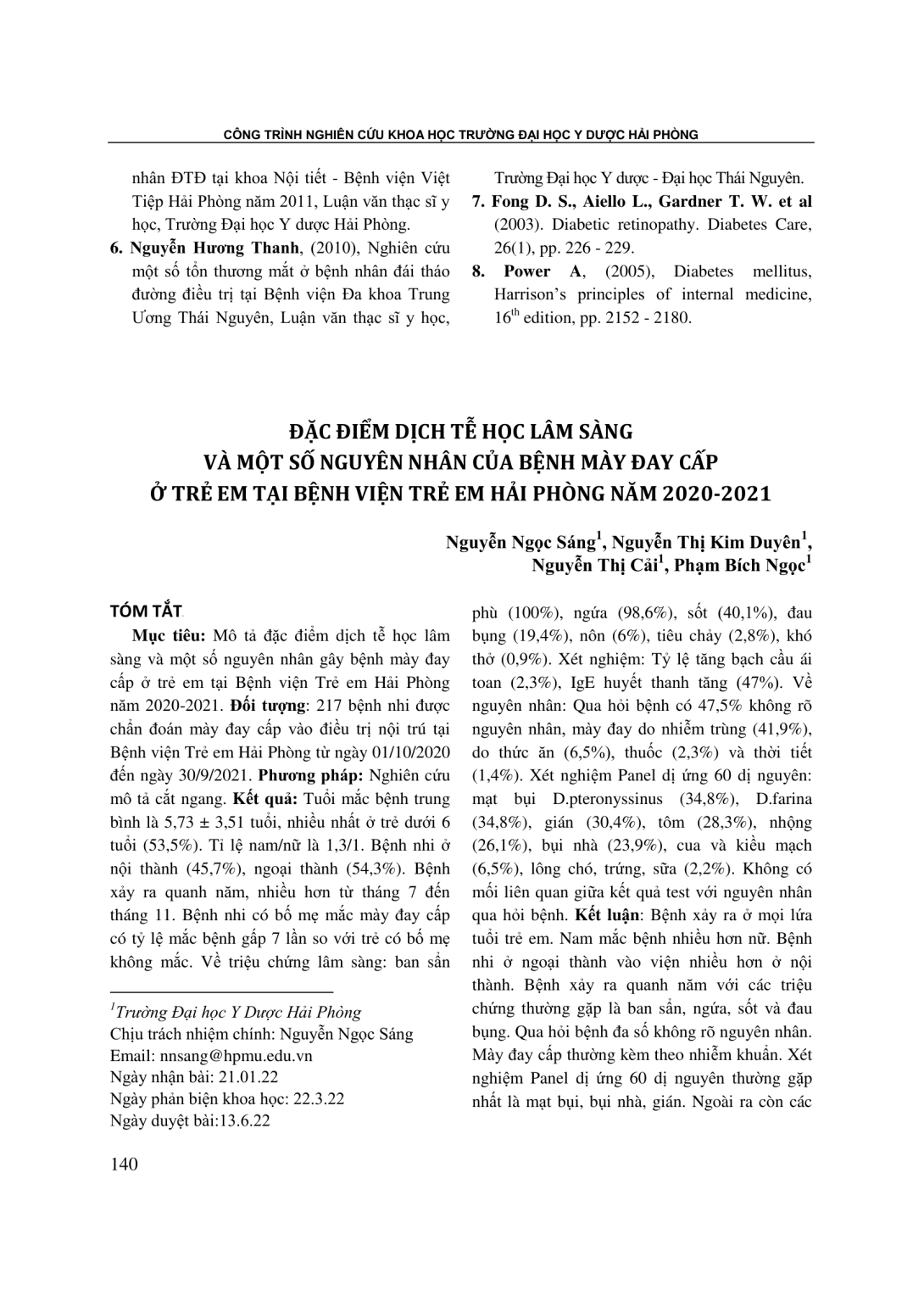
Mô tả đặc điểm dịch tễ học lâm sàng và một số nguyên nhân gây bệnh mày đay cấp ở trẻ em tại Bệnh viện Trẻ em Hải Phòng năm 2020-2021. Đối tượng: 217 bệnh nhi được chẩn đoán mày đay cấp vào điều trị nội trú tại Bệnh viện Trẻ em Hải Phòng từ ngày 01/10/2020 đến ngày 30/9/2021. Phương pháp: Nghiên cứu mô tả cắt ngang. Kết quả: Tuổi mắc bệnh trung bình là 5,73 ± 3,51 tuổi, nhiều nhất ở trẻ dưới 6 tuổi (53,5%). Tỉ lệ nam/nữ là 1,3/1. Bệnh nhi ở nội thành (45,7%), ngoại thành (54,3%). Bệnh xảy ra quanh năm, nhiều hơn từ tháng 7 đến tháng 11. Bệnh nhi có bố mẹ mắc mày đay cấp có tỷ lệ mắc bệnh gấp 7 lần so với trẻ có bố mẹ không mắc. Về triệu chứng lâm sàng: ban sẩn phù (100%), ngứa (98,6%), sốt (40,1%), đau bụng (19,4%), nôn (6%), tiêu chảy (2,8%), khó thở (0,9%). Xét nghiệm: Tỷ lệ tăng bạch cầu ái toan (2,3%), IgE huyết thanh tăng (47%). Về nguyên nhân: Qua h i bệnh có 47,5% không rõ nguyên nhân, mày đay do nhiễm trùng (41,9%), do thức ăn (6,5%), thuốc (2,3%) và thời tiết (1,4%). Xét nghiệm Panel dị ứng 60 dị nguyên: mạt bụi D.pteronyssinus (34,8%), D.farina (34,8%), gián (30,4%), tôm (28,3%), nhộng (26,1%), bụi nhà (23,9%), cua và kiều mạch (6,5%), lông chó, trứng, sữa (2,2%). Không có mối liên quan giữa kết quả test với nguyên nhân qua h i bệnh. Kết luận: Bệnh xảy ra ở mọi lứa tuổi trẻ em. Nam mắc bệnh nhiều hơn nữ. Bệnh nhi ở ngoại thành vào viện nhiều hơn ở nội thành. Bệnh xảy ra quanh năm với các triệu chứng thường gặp là ban sẩn, ngứa, sốt và đau bụng. Qua h i bệnh đa số không rõ nguyên nhân. Mày đay cấp thường kèm theo nhiễm khuẩn. Xét nghiệm Panel dị ứng 60 dị nguyên thường gặp nhất là mạt bụi, bụi nhà, gián. Ngoài ra còn các dị nguyên khác như sữa bò, lòng trắng trứng, cua và cà chua ít gặp hơn.
To describe some clinical epidemiology characteristics and some causes of acute urticaria in children admitted to Hai Phong Children hospital in 2020-2021. Subjects: 217 patients diagnosed with acute urticaria at Haiphong children’s hospital during the study period from October 1st, 2020 to September 30th, 2021.Methods: Cross-sectional study. Results: The average age of the patients is 5.73±3.51 years, ages under 6 accounts for the majority. The male / female ratio is 1.3/1. The percentage of children in urban areas who suffer from acute urticaria is 45.7%, which is lower than in suburban areas with 54.3%. Acute urticaria patients are hospitalized all year round, but more often in the months of July to November. Children whose parents have allergies are 7 times more likely to develop urticaria than others. Common symptoms are wheals (100%), itchy (98.6%), fever (40.1%), abdominal pain (19.4%). Patients had eosinophilia (2.3%), 47% of patients increased serum IgE. Through question, 47.5% of patients had undefined causes, infectious causes were the most common (41.9%), followed by food (6.5%), weather (1.4%). Allergy Test Panel (allergen-specific IgE test) dust mite D.pteronyssinus (34.8%), D.farinae (34.8%), cockroach (30.4%); shrimp (28.3%), silkworm pupa (26.1%) and house dust (23.9%), followed by crab, buckwheat. Cow’s milk, egg white only 2.2%. There is no relationship between the allergen-specific IgE test results and the patients’ causes when questioned. Conclusion: The disease occurs at all ages and in males more than female children. Children in the suburbs are more hospitalized than in the inner city. The disease occurs year-round with common symptoms of rash, itching, fever and abdominal pain. Most of the patients did not know the causes of acute urticaria when questioned. Acute urticaria is often accompanied by infection. Test Allergy Panel 60 most common allergens are dust mites, house dust mites, cockroaches, silkworm pupa, shrimp, cow's milk allergens, egg whites, tomatoes less commonly.
- Đăng nhập để gửi ý kiến
